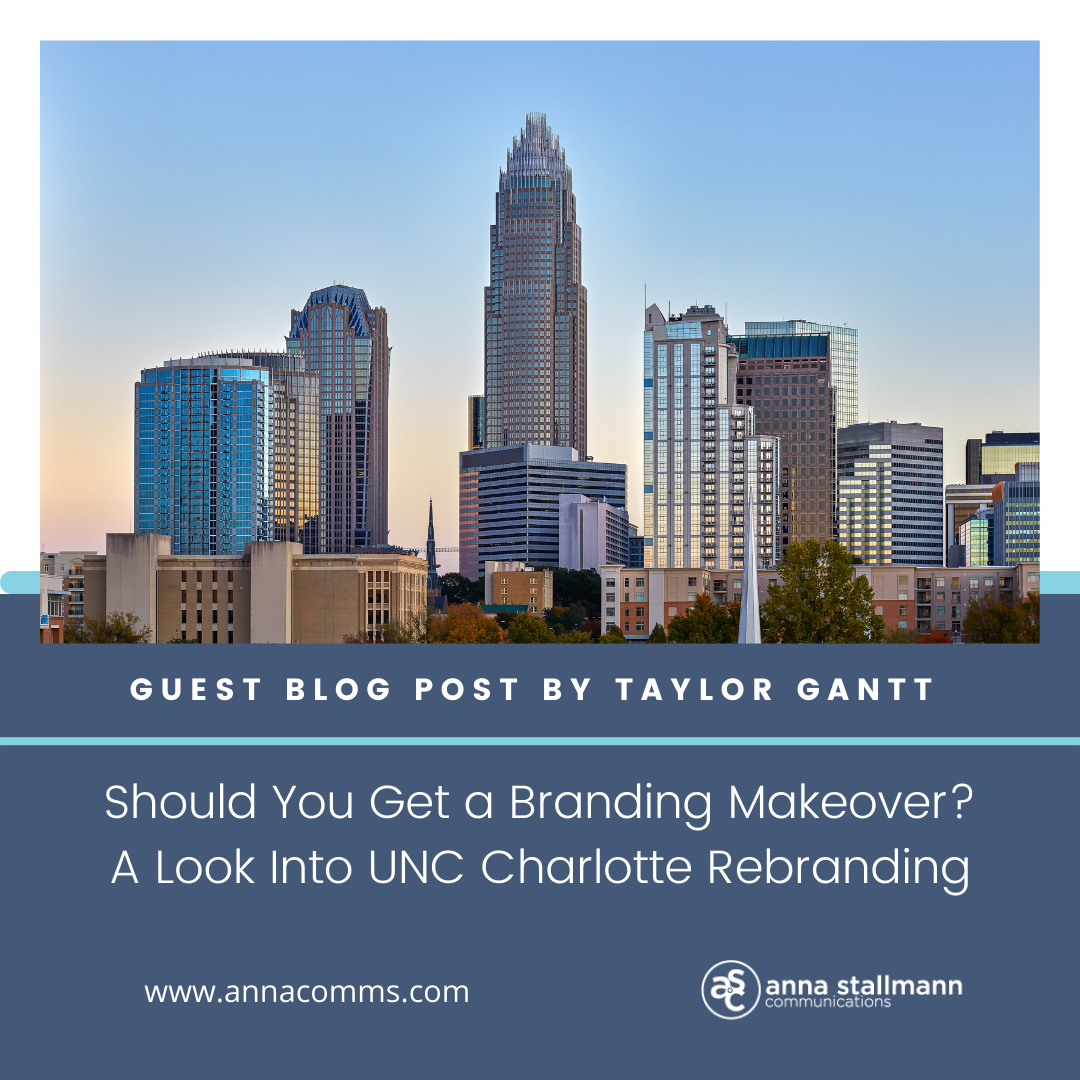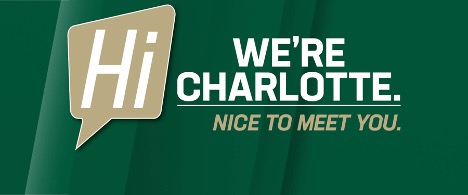UNC Charlotte has a new look, and also a new name.
Seventy-five years ago, a group of trailblazing leaders had a vision to transform an evening college center with only 278 students into a thriving research university of over 30,000 students, now known as The University of North Carolina at Charlotte, or just “Charlotte.” Now, this day is known as Founder’s Day.
Today, Charlotte will be celebrating Founders Day and their 75th anniversary with a makeover.
As a student at UNC Charlotte and an intern at Anna Stallmann Communications, I wanted to share perspective on why this rebranding matters.
What’s changing?
Everything from email addresses, signage, the website (uncc.edu to charlotte.edu), and logos.
Why is this important?
Well, The University of North Carolina at Charlotte is the second largest university in North Carolina. Founded in 1964, the University boasts 171 undergraduate majors, 79 bachelor’s degrees, and 150 programs leading to 66 master’s degrees and 24 doctoral degrees.
Outdated branding can keep audiences from recognizing an organization and what they actually believe in. Making sure the branding reflects the organization’s strengths and beliefs is necessary for success. The University of North Carolina at Charlotte is an integral part of the growing and dynamic Charlotte community, and the new brand does a great job of reflecting that.
What does this mean for brand application?
UNC Charlotte and University of North Carolina at Charlotte are still appropriate names according to the University; however, “Charlotte” is the new informal, adopted name to reference the University, replacing “UNCC.” For formal and official purposes, The University of North Carolina at Charlotte should be used.
Charlotte explicitly states that these examples are not to be used moving forward:
-
UNCC
-
UNC-C
-
UNC-Charlotte
-
University of NC at Charlotte
-
University of North Carolina-Charlotte
-
University of North Carolina Charlotte
-
University of Charlotte
-
Charlotte University
From a branding perspective, it is always important to not leave room for wrong interpretation. Brand guidelines and standards, as UNC Charlotte set out, should include inaccurate applications of the brand.
No need to worry though, UNC Charlotte is still part of the UNC System, and proud to be a part of the long tradition of educating students in North Carolina and beyond.
Most students report a positive reaction to Charlotte rebranding. “I think that the rebrand adds to our prestige and it’s indicative of our stature as a university. I’m excited to see us finally grow into our own and move away from the “UNCC,” said Charlotte American Marketing Association VP of Finance, Blaine Davis. He added “I think we’ve lost our traction the past few years establishing a unique identity.”
Charlotte is celebrating by rebranding not only their name, but their logo as well.
Last year, Charlotte Athletics debuted the All-in-C logo, which features a block style letter “C” with a pickaxe, which you may recognize because it is used by the Charlotte mascot, Norm the Niner. This year, Charlotte has adopted the All-in-C logo to be used cohesively across the university.
Consistent and cohesive branding goes beyond logos, however. It expands to brand colors, fonts, and quality across all digital, social, and printed media. Having a comprehensive brand guideline helps the organization and employees live up to those brand standards.
For UNC Charlotte, the prominent logo will feature the All-in-C block logo accompanied with “University of North Carolina, Charlotte.”

The additional logo will feature the Charlotte All-in-C block logo without text. It will also be accompanied with “Charlotte.”
![]()

“The All-in-C represents the power to break new ground, the persistence to discover the unknown and the promise to build the future,” said the university. The consistency of these logos, font, and coloring are essential to brand reputation.
Charlotte student Victoria Torres, Vice President of American Marketing Association said, “at first I felt unsure about the new logo. It didn’t feel normal, since I joined the University when they used the crown and axe logos.” She added, “the new logo grew on me and I was able to see the image it could bring to the University. I think it encompasses our Niner identity and shows that we are growing with our city, Charlotte.”
So when is it time for a rebrand?
We live in an ever-changing world where the ability to adapt is necessary to succeed. For organizations like UNC Charlotte and others, this change comes in the form of rebranding. Organizations need to be able to hold true to their values and essence of their company while also changing and evolving.
Should your company consider rebranding? Consider these indicators that you may be overdue to rebrand.
Your brand is outdated.
If your brand does not adapt to the times and no longer appeals to your audience, then you will quickly lose that audience and fail to recruit a new one.
Your existing brand is restrictive.
Your brand needs to accurately reflect its operations and offerings, so if there comes a time when what you offer becomes narrow, consider rebranding!
Your existing branding is weak.
If your brand is not attracting new customers, then it is not doing its job. In a competitive market, weak branding will hold your organization back. Take the time to reflect on your target audience, what is important to them, and then create a brand that aligns with the two. It is also important to understand the history of your brand and the future it hopes to bring.
Rebranding can be a tricky process. But if executed well and thoughtfully, you will experience significant benefits. Be sure to do your research and connect with experts (like ASC) to create a detailed plan and successfully move through the process.
My take? The rebranding of UNC Charlotte has an overall positive perception that demonstrates how the University is growing and becoming more dynamic, much like the city of Charlotte itself. Well done, Charlotte!
This blog post was written by Taylor Gantt, a student at The University of North Carolina at Charlotte and an intern with Anna Stallmann Communications.

